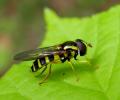Who is here? 1 guest(s)
|
aquatic stratiomyidae
|
|
| atylotus |
Posted on 29-01-2010 17:06
|
|
Member Location: Posts: 1112 Joined: 29.05.09 |
I'm trying to rear the aquatic larvae of Odontomyia and Oplodontha, but yet I didn't succeed fully. Only 1 O. tigrina emerged, but died without getting hardened. I have done this while putting the larvae in an aquarium with just water and I have tried it in wet moss, but alas. It must be over 15 years now, that I have reason to believe that most of the diagnostic features of Odontomyia and Oplodontha larvae are incorrect. In fact, for The Netherlands, all larval identifications of these two genera, at least in Odontomyia, are false. It won't get out of my head, but I can't prove it. Does anybody have a clue in how to rear them? or does anybody have some reared material for study purposes? Many thanks in advance. |
|
|
|
| Cranefly |
Posted on 29-01-2010 20:49
|
|
Member Location: Posts: 646 Joined: 17.09.08 |
I failed almost always with aquatic larvae. Many of them migrate to soil or sand before pupation (you never know what humidity is necessary) - possibly moist with good aeration but not wet. I use Sphagnum sometimes to rear larvae because it holds humidity well and a little antiseptic. I reared Ephydra putting pupa by one in a tube with moist moss and cotton cup and besides this all tubes were together inside closed box with moist filter paper. I put this box in the sun for 1-2 hours every day. In any case I'll try to rear some Stratiomyiidae this summer. |
|
|
|
| Cranefly |
Posted on 30-01-2010 07:36
|
|
Member Location: Posts: 646 Joined: 17.09.08 |
I want to add that early spring in the best time for collecting for larvae which hibernate at larval stage. When they are taken under warm laboratory conditions they emerge quickly. When you collect in summer you dont't know their age. And as for larvae taken in autumn - I put them into fridge till middle of January and water them (2-5 drops of water) every 4-6 days. As soon as you take them out they pupate and emerge at the end of January - February. It is necessary for some species that the pupa must be hold by substratum and be immobile at the moment when imago emerges. It supports imago at the moment of leaving the pupa and no damages of wings and legs happen. |
|
|
|
| atylotus |
Posted on 02-02-2010 09:20
|
|
Member Location: Posts: 1112 Joined: 29.05.09 |
Thanks for the info, I will try your method this spring and I'll hope it will yield some Odontomyia species and Oplodontha. O. tigrina, O.ornata and O.viridula are very common here, so sampling will not be of any problem. |
|
|
|
| Jump to Forum: |













 but don't see the image in the post.
but don't see the image in the post.
